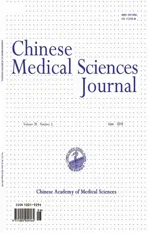1.9 μm Thulium Laser Treats Ureteral Carcinoma via Rigid-ureteroscopy
2016-03-25JinWenZhigangJiandHanzhongLiDepartmentofUrologyPekingUnionMedicalCollegeHospitalChineseAcademyofMedicalSciencesPekingUnionMedicalCollegeBeijing100730China
Jin Wen, Zhi-gang Ji*, and Han-zhong LiDepartment of Urology, Peking Union Medical College Hospital, Chinese Academy of Medical Sciences & Peking Union Medical College, Beijing 100730, China
CASE REPORT
1.9 μm Thulium Laser Treats Ureteral Carcinoma via Rigid-ureteroscopy
Jin Wen, Zhi-gang Ji*, and Han-zhong Li
Department of Urology, Peking Union Medical College Hospital, Chinese Academy of Medical Sciences & Peking Union Medical College, Beijing 100730, China
laser theraoy; carcinoma; uooer urinary tract; ureteroscooic treatment
Chin Med Sci J 2016; 31(2):127-128
R ADICAL nephroureterectomy is the gold standard treatment for patients with upper urinary tract urothelial cell carcinomas.1However, ureteroscope has enabled urologists to easily approach the
2upper urinary tract and resect tumor. Patients for whom endoscopic tumor resection is recommended included those with a solitary kidney, renal insufficiency, bilateral transitional cell carcinoma (TCC) of the upper urinary tract,or a high risk of medical complications associated with open surgery.3, 4We report 4 cases of ureteral carcinomas cured by 1.9 μm thulium laser treatment via rigid-ureteroscopy.
CASE DESCRIPTION
From June 2012 to June 2014, 4 patients with urothelial cell carcinomas of the upper urinary tract underwent 1.9 μm thulium laser treatment via rigidureteroscopy in Peking Union Medical College Hospital. They aged from 63 to 88 years with a mean age of 71.2 years at the time of diagnosis. The average tumor size was 1.1 (range, 0.3-1.5) cm in diameter. Patients were well informed about the risks and benefits of nephroureterectomy relative to those by endoscopic treatment. The choice was based on the size, location, renal function, and clinical grade of the tumor. One surgeon performed all the procedures. Patient was placed in the lithotomy position under general anaesthesia. We employed an 8.0-9.8F rigid ureterorenoscope (Wolf, Germany) and a Vela® XL 1.9 μm laser system (Starmedtec, Germany). The delivery system was a bare-ended laser fiber with a 600 µm optical core diameter. The laser energy was set to 50 W during surgery. All the patients were diagnosed endoscopically, and specimens were obtained by biopsy with cup forceps. A 6-Fr ureteral stent was left in situ at the end of the procedure to ensure postoperative drainage and prevent transient obstruction secondary to ureteral edema. The stent was removed 3 months later. All samples were sent to the laboratory to be assessed by a single specialist. Patients were examined by ureteroscopy every 3 months for the first 2 years, followed by ureteroscopy every 6 months. Recurrence was defined as visible tumor detected by ureteroscopy.
All patients were treated successfully. No perforations and bleeding occurred during the ureteroscopic procedures,whereby none of the patients required blood transfusion or emergency open surgery. The tumor was rated as lowgrade in 3 patients and high grade in 1 patient. Ureteral stricture developed in 1 patient 3 months after removal of a multilocal tumor, but the stricture responded to endoscopic dilation. Disease progression and the need for subsequent nephroureterectomy have not occurred in our series.
DISCUSSION
Development of endourological procedures and laser technique has stimulate the more widespread use of renalsparing surgery. Endoscopic treatment is feasible and safe for small, localized, low-grade superficial TCC of the upper urinary tract. The neodymium laser is not recommended for the treatment of urethral strictures because of the resulting depth of thermal injury to the tissues.5, 6The holmium laser causes a thermal injury about 0.4 mm in depth,7but this is still deeper than the thermal injury depth of 0.18 mm caused by the RevolixTMthulium laser and of 0.1 mm caused by the newer thulium: YAG lasers with a wavelength of 1920 nm.8, 9
In this study, the Vela® XL 1.9 µm thulium laser system with wavelength of 1920 µm was used. The depth of thermal injury caused by this laser is only about 0.1 mm,and the laser can be used to achieve precise, scar-free surgery to the surface of the ureter. In general, tumor grade plays a role as the most important prognostic indicator for recurrence and progression of TCC. The recurrence rates were lower in our series because patients with low grade tumors in 3 patients. One patient with circumferential lesions of the ureter developed ureteral scarring and subsequent stricture formation.
Careful follow up constitutes an essential part of our conservative surgical modality.
Upper urinary tract evaluation is usually more intensive after endoscopic resection than after nephroureterectomy. In our opinion, CT scanning cannot readily detect small tumors, thereby being unable to reliably identify multifocal lesions.
Ureteroscopy is useful for monitoring patients after endoscopic treatment of upper tract TCC. However, it is essential for patients to understand that there will be frequent recurrences and that lifetime follow up is necessary.
REFERENCES
1. Golan S, Nadu A, Lifshitz D. The role of diagnostic ureteroscopy in the era of computed tomography urography. BMC Urol 2015; 15:74.
2. Defidio L, De Dominicis M, Di Gianfrancesco L, et al. Improving flexible ureterorenoscope durability up to 100 procedures. J Endourol 2012; 26:1329-34.
3. Suriano F, Brancato T. Nephron-sparing management of upper tract urothelial carcinoma. Rev Urol 2014; 16:21-8. 4. Elliott DS, Segura JW, Lightner DJ, et al. Long-term results of conservative endourologic management of upper tract transitional cell carcinoma in individuals with a normal contralateral kidney. Urology 2001; 58:174-8.
5. Smith JA, Dixon JA. Contact neodymium: YAG laser ablation of recurrent urethral strictures using a side-firing fiber. J Endourol 2003; 17:791-4.
6. Liao JC, Leppert JT. Turning on the lights: new technologies in optical diagnostics and therapeutics. J Urol 2013;190:381-2.
7. Kuntz RM. Current role of lasers in the treatment of benign prostatic hyperplasia (BPH). Eur Urol 2006; 49:961-9.
8. Fajkovic H, Klatte T, Nagele U, et al. Results and outcomes after endoscopic treatment of upper urinary tract carcinoma: the Austrian experience. World J Urol 2013;31:37-44.
9. Bach T, Herrmann TR, Cellarius C, et al. Bladder neck incision using a 70 W 2 micron continuous wave laser (RevoLix). World J Urol 2007; 25:263-7.
for publication August 12, 2015.
*Corresponding author Tel: 86-10-69156031, E-mail: jzgjxmc@163.com
